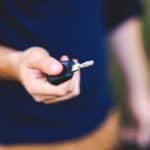Taking the driving test for the first time is an exciting experience. Being anxious is completely normal since having a driver’s license is a life changer. The objective of this article is helping you prepare for this important exam by giving you tips and facts regarding the driving test.
Everything you need to know about the driving test is right ahead so put your seatbelt on!
Skipping the driving test, is it possible?
A fact few people are aware of is that under certain circumstances you can skip the road test. Unfortunately, this doesn’t apply for first-time applicants but still can benefit people that meet the following conditions:
- If you live in the USA, you can skip the road test if you already have a valid driver’s license issued by another state.
- If you plan to live in the USA, you can also skip the road test by exchanging your foreign driver’s license for its local counterpart. This only applies to countries with reciprocity agreements with the state you plan to apply for the permit. Some of these countries are Canada, France, Germany, South Korea, Taiwan, and Japan. Contact the local Department of Motor Vehicles (DMV) for more information. In a similar way, the US driver’s license can be swapped by a local equivalent in all those countries.
- If you live in Europe and your country is part of the European Economic Area (EEA) then your driver’s license is valid across all EAA zone.
- If you plan to live in the United Arab Emirates (UAE), you can skip the driving test if your original license was issued by China, Austria, Slovakia, Luxembourg, Portugal, Finland, Romania, Denmark, Serbia, Poland, Netherlands, Latvia, Lithuania, and most of EEA countries.
Booking the road test, choosing road test center wisely
The driving test cannot be taken freely, it must be done by appointment. What few people know is that in most countries you can choose the testing center where you want to take the exam. If you live in a highly populated area chances are that your instructor will have limited time and patience since many tests need to be completed each day. Our suggestion is choosing a testing center in a less crowded city, believe it or not, that little detail can benefit you during the test.
Practicing for the driving test
Most countries issue a provisional license, also know as learner’s permit, that is also a requisite for the driving test. Take full advantage of the learner’s permit and practice all you can before the real test. Our suggestion is to split your “training” into several milestones:
- Newbie level: Start practicing for the driving test in empty parking lots, or in low traffic areas. Avoid places with tight roads, stop signals, traffic lights, and so. The goal of this phase is gaining confidence in your driving skills and getting to know the pedals and instruments. You don’t need to go fast nor to learn how to drive reverse or park.
- Moderate level: Once you feel comfortable driving forward in low traffic areas is time to go a step further. Our suggestion is continuing practicing in empty parking lots but with some obstacles on the road. Use boxes, traffic cones, any object that won’t damage your car in case of an accidental collision. Start practicing reverse driving and parking.
- Real traffic level: Our suggestion is to face real traffic situations only after feeling absolutely comfortable. Start little by little, on residential areas first and then on low traffic roads. By now you should be able to check road signs with confidence because your driving skills should let you deviate your sight from the wheel.
By law, during all your practice sessions you should be accompanied by a certified driver. Always hear what he or she has to say. Constructive feedback is key during this process. For even better results our advice is hiring a quality driving instructor.
How to improve your driving test success rate
There are some tips that will improve your success rate during the driving test:
- Practice near the testing area: Investigate in your local traffic center where is the test done. Usually, the driving test is performed in residential and commercial areas near the test center. Practicing your driving skill in the same area will bolster your confidence during the exam.
- Know the vehicle you will drive: Is not uncommon that the examiner asks you several questions about the car. Typical ones are: how to turn on and off the lights, use of turning signals, defroster, etc.
- Listen to the examiner: Always follow examiner’s directions. Even if you feel you are driving at the right speed don’t argue if he or she asks you to go slower.
- Drive on different weather conditions: You can’t anticipate weather conditions during the driving test. A good idea is to practice your skills during different conditions to boost your confidence and avoid unpleasant surprises during the test.
Driving test requisites
Before taking the driving test check that you have ready all requisites. Documentation can vary from one region to another as well as prerequisites, but for most countries, you will need the following:● A vehicle that fulfills the security parameters set by your local traffic authority.
- Valid vehicle registration and proof of insurance.
- A valid learner’s permit
- Be accompanied by a licensed driver 21 years or older.
- Theory test certification.
Failing to bring the requisites to the driving test may cause the cancellation of your appointment as well as additional fees. Check your local traffic authority for more information.
Taking The Driving Test, What To Expect From It?
First things first. Arrive at least 15 minutes before your appointment. Don’t risk cancellation due to a delay. The driving test goal is to certify that you are prepared to deal with real-world traffic situations in a safe manner. Driving tests vary from one location to another, but in general terms, you can expect the instructor to test your following skills:
- Driving through intersections.
- Backing up around a corner.
- Three-point turns.
- How you manage to change lanes and passing vehicles.
- Highway driving (entering and exiting highway).
- Parallel parking.
- Turn signal usage.
- Speed limit adequation.
- Appropriate distance with other vehicles.
- Mirrors and blind spot usage.
- Knowledge of traffic signs and signals.
Besides the actual driving test, the examiner could also ask you several questions regarding vehicle controls, and make you turn lights and wipers on and off.
Tips during the driving exam
Our top recommendations once the driving test has started are:
- Relax. You had a lot of practice, this is just one more ride.
- Gear the seat belt at all times.
- Check and adjust the mirrors before start moving, even if they are ok. Once driving check mirrors regularly.
- Keep both hands on the wheel at all times.
- Be aware of changes in the speed limit when passing from one zone to another. For example, from residential streets to freeways.
- Anticipate pedestrians, pay attention to crosswalks and remember that they always have precedence.
- Show confidence during the test even if you feel that made a mistake. The examiner doesn’t expect perfection but confidence.
- Drive safe, maintain a constant speed when possible.
- Accelerating and braking smoothly is a great plus during the test thus demonstrates you have the necessary practice.
- Have the confidence to look at the traffic signs. You don’t need to speak them loud but show that you can look at them without distracting from the road.
What To do if failing the driving test
Even with lots of practice and preparation, the driving test can quickly go south if you get anxious or by accident make a big mistake. Even failure is something difficult to accept, keep in mind that you can always repeat the test again. Take note of your mistakes and get back to practice, that way you will excel and will have no issues passing your next driving test.



